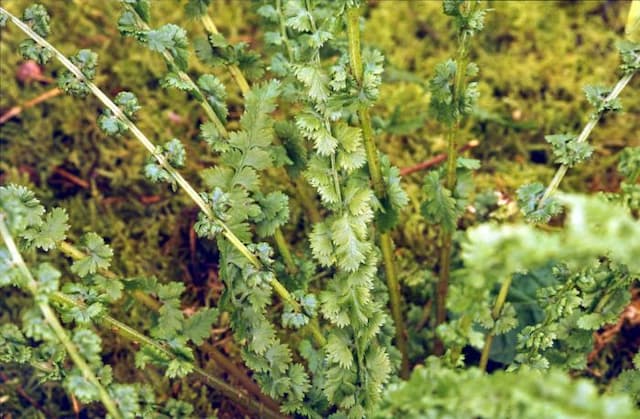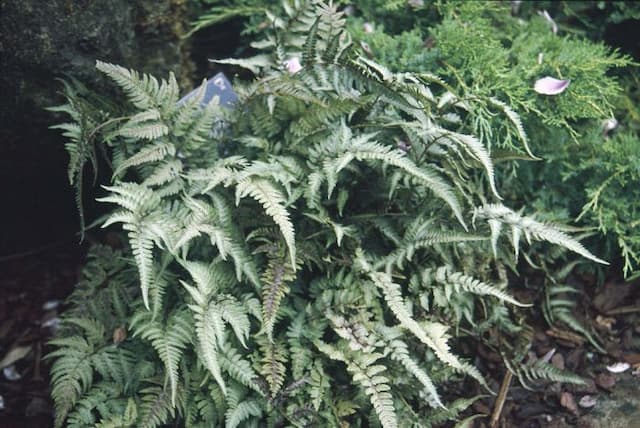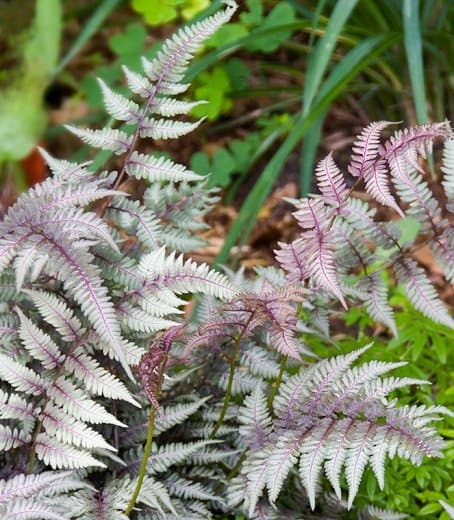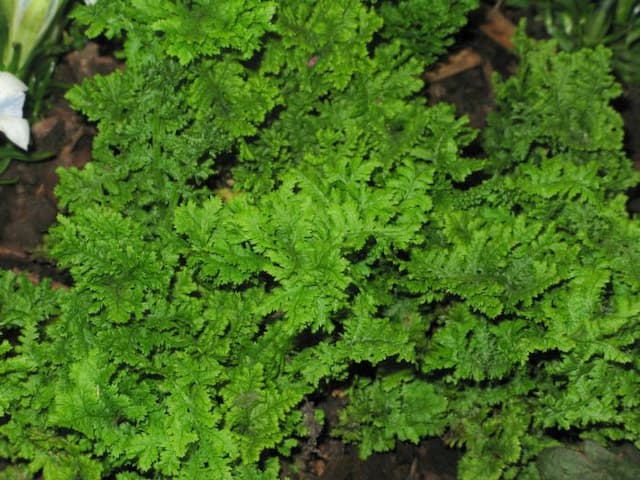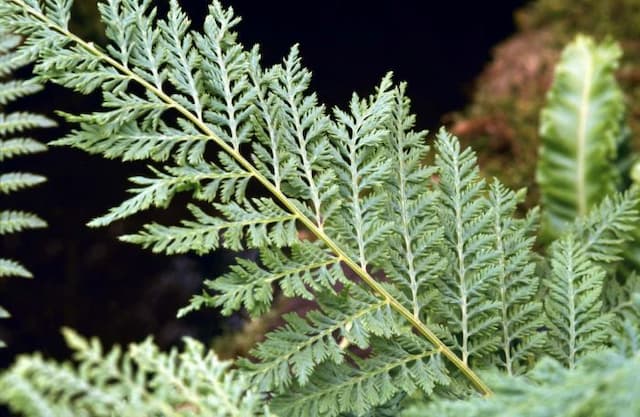Japanese Painted Fern Athyrium 'Ocean's Fury'

ABOUT
Athyrium 'Ocean's Fury' is a type of fern that stands out with its distinctive foliage. The leaves, also known as fronds, emanate an aura of motion, much like tumultuous ocean waves, which is where it derives its evocative name. These fronds display a complex texture, marked by ruffled edges that contribute to a dramatic, almost theatrical character in the garden. The leaflets, which line each side of the frond's central stem, look like they have been intricately cut and curled, giving the plant a lacy, finely dissected appearance. The color of 'Ocean's Fury' can be described as a rich, vibrant green that may have subtle undertones of another hue, often resulting in a two-toned effect that adds depth and visual interest. As light filters through the fronds, it highlights the complexity and detail of their structure, emphasizing their curved and contoured surfaces. While the fern does not flower, its ornamental value lies purely in the beauty and form of its foliage, which offers a unique texture and movement to a shaded garden spot or container. Gardeners appreciate this plant for its ability to blend in with other shade-loving plants, providing a backdrop that is both dynamic and robust in appearance. Its ability to evoke the essence of a churning sea makes it a compelling choice for adding a touch of drama to a landscape that thrives in the gentle and calming presence of greenery.
About this plant
 Names
NamesFamily
Athyriaceae
Synonyms
Ocean's Fury Painted Fern, Ocean's Fury Lady Fern
Common names
Athyrium 'Ocean's Fury'
 Toxicity
ToxicityTo humans
The plant known as Athyrium 'Ocean's Fury', commonly referred to as fern, does not have a well-documented profile of toxicity towards humans. Most fern species are not known to be toxic, and there are no widespread reports of poisoning from ingesting this plant. However, it is generally advisable to avoid eating any part of ornamental plants due to the potential for adverse reactions or unknown toxicity.
To pets
Similar to humans, Athyrium 'Ocean's Fury', commonly known as fern, is not commonly known to be toxic to pets. There are many different types of ferns, some of which may have mild toxicity, but there is no specific information suggesting that Athyrium 'Ocean's Fury' is harmful to pets. Nonetheless, it is always best to prevent pets from ingesting plants as they may cause digestive upset or an allergic reaction in some animals.
 Characteristics
CharacteristicsLife cycle
Perennials
Foliage type
Deciduous
Color of leaves
Green
Height
1-2 feet (30-60 cm)
Spread
1-2 feet (30-60 cm)
Plant type
Fern
Hardiness zones
4-9
Native area
Varies
Benefits
 General Benefits
General Benefits- Ornamental Value: Athyrium 'Ocean's Fury' adds aesthetic appeal to gardens with its unique, ruffled fronds and silver-blue hue.
- Shade Tolerance: This plant is well-suited for shaded areas where many plants struggle to thrive.
- Soil Improvement: As a fern, it can help in maintaining soil moisture and preventing erosion in the garden.
- Wildlife Habitat: Provides cover and habitat for various species of insects and small wildlife.
- Low Maintenance: It is relatively easy to care for, requiring minimal pruning and is generally pest-resistant.
- Seasonal Interest: Offers visual interest throughout the growing season with its changing foliage texture and color.
 Medical Properties
Medical PropertiesThis plant is not used for medical purposes.
 Air-purifying Qualities
Air-purifying QualitiesThis plant is not specifically known for air purifying qualities.
 Other Uses
Other Uses- The fronds of the fern can be used in floristry for adding a delicate, feathery texture to bouquets and floral arrangements.
- Ferns like the Athyrium can be used in terrariums or fairy gardens to create a miniature forested landscape.
- Dried fern fronds can be utilized in crafts, such as creating natural-themed bookmarks, or for pressing into decorative patterns on paper or fabric.
- The distinctive foliage can serve as inspiration for artists and designers in patterns for textiles, wallpaper, or other graphic designs.
- Ferns can be incorporated into educational tools for schools and workshops to teach about plant biology and the evolution of vascular plants.
- Its unique appearance can be used for theming in entertainment venues, such as creating an 'underwater' ambiance in aquariums or ocean-themed spaces.
- Gardeners may choose to plant the fern as a living mulch to help retain soil moisture and suppress weed growth in garden beds.
- Ferns can be used in pond landscaping to create a natural transition between the water and land in backyard ponds or water gardens.
- Photographers might use the intricate patterns of the fern leaves as subjects or backdrops for macro photography to capture the beauty of nature’s details.
- Pet owners sometimes plant nontoxic ferns like the Athyrium to provide safe, live plants in the habitats for reptiles and amphibians.
Interesting Facts
 Feng Shui
Feng ShuiThe Lady fern is not used in Feng Shui practice.
 Zodiac Sign Compitability
Zodiac Sign CompitabilityThe Lady fern is not used in astrology practice.
 Plant Symbolism
Plant Symbolism- Resilience: Athyrium 'Ocean's Fury', also known as the 'Japanese Painted Fern', often symbolizes resilience due to its ability to thrive in shady environments and its lush, hearty foliage that weathers well in different conditions, akin to weathering the storms much like the ocean's fury.
- Elegance: The graceful and arching fronds of the Japanese Painted Fern bring to mind a sense of elegance and poise, making it a symbol of grace and beauty in the plant world.
- Tranquility: The soft, green hues and the gentle sway of this fern's leaves can evoke a feeling of tranquility and peace, often making it a popular choice for serene garden settings or as a representation of calmness.
- Endurance: Reflecting the theme of toughness, the Japanese Painted Fern's robust nature and its ability to persist in less than ideal conditions symbolize endurance and the capacity to survive and flourish despite challenges.
- Protection: Ferns in general have historically been associated with protection due to their densely leafed fronds. The Japanese Painted Fern's lush foliage might be interpreted as a symbol of shelter and safety, offering a protective cover in the natural world.
 Water
WaterThe Japanese Painted Fern should be kept consistently moist but not waterlogged. This delicate fern prefers a thorough watering, allowing the top inch of soil to dry out slightly before watering again. Depending on the humidity and temperature, this could mean watering once every week with about 16 ounces of water for an average-sized pot or adjusted as needed to maintain moisture without over-saturating the soil. It is crucial to avoid letting the plant sit in standing water to prevent root rot.
 Light
LightJapanese Painted Fern thrives best in partial to full shade. It should be placed in a spot where it receives filtered sunlight or dappled shade throughout the day. Direct sunlight can scorch its delicate fronds, so it is ideal under the canopy of larger plants or trees or even on a north-facing window where bright, indirect light is prevalent.
 Temperature
TemperatureJapanese Painted Fern grows best in temperature ranges between 60 to 75 degrees Fahrenheit and can endure minimum temperatures down to about 50 degrees Fahrenheit. Extreme cold or heat can be detrimental to the plant, so it should be protected from frost and high temperatures above 80 degrees Fahrenheit, which can cause the fronds to wilt.
 Pruning
PruningPruning the Japanese Painted Fern involves removing any dead or damaged fronds to encourage healthy growth and improve airflow. This task is best performed in the spring to allow for new growth to come in and should be done as needed throughout the season to maintain the plant's tidy appearance. Regular pruning also helps prevent disease and pest infestations.
 Cleaning
CleaningAs needed
 Soil
SoilJapanese Painted Fern 'Ocean's Fury' prefers a soil mix rich in organic matter with good drainage. A mix of one part garden soil, one part peat or coconut coir, and one part perlite or sand is ideal. This fern thrives best in slightly acidic to neutral soil, aiming for a pH range between 5.5 and 7.0.
 Repotting
RepottingJapanese Painted Fern 'Ocean's Fury' should be repotted every two to three years. It's important to refresh the soil and increase the pot size if the roots have outgrown the current container, ensuring adequate space for growth and nutrient absorption.
 Humidity & Misting
Humidity & MistingJapanese Painted Fern 'Ocean's Fury' requires high humidity levels, typically above 60%. To thrive, it is necessary to maintain consistently moist air around the plant without watering the fern directly into the fronds to prevent fungal diseases.
 Suitable locations
Suitable locationsIndoor
Place in shade, keep soil moist, boost humidity.
Outdoor
Plant in shade, mulch well, keep soil moist.
Hardiness zone
4-9 USDA
 Life cycle
Life cycleAthyrium 'Ocean's Fury', commonly known as a type of Lady Fern, starts its life cycle with spore germination. Upon finding a suitable moist environment, the spores grow into a heart-shaped gametophyte, which is the sexual stage of the plant. The gametophyte produces both eggs and sperm, and when water is present, fertilization can occur, leading to the development of a new sporophyte—what we recognize as the fern. The sporophyte emerges as a small fiddlehead, which unfurls into a frond, the leafy part of the fern. The fern matures and develops sori on the underside of its fronds, which are clusters of spore-producing structures. As the plant ages, these spores are released into the environment to begin the cycle anew.
 Propogation
PropogationPropogation time
Spring-Early Summer
Propogation: The Athyrium 'Ocean's Fury', commonly referred to as a type of Fern, is generally propagated in the spring or early summer to take advantage of warmer temperatures and increased daylight, which facilitate growth. Ferns, including 'Ocean's Fury', are most commonly propagated through division. This involves carefully digging up the plant, shaking off the soil, and gently separating it into smaller sections, each with its own set of fronds and roots. These sections are then replanted in moist, well-draining soil, ideally in a shaded or semi-shaded area. It is important to keep the newly planted sections well-watered especially in the first few weeks to ensure that they establish their root system effectively.
